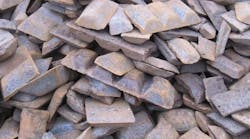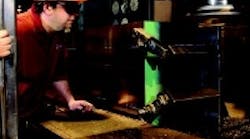Dura-Bar debottlenecked this rough milling operation by switching to tangential milling. Ingersoll's S-MAX cutter raised throughput by 60% and edge life by more than 2 to 1. The gain eliminated the cost of an extra shift and outsourcing to keep pace with orders.
Simple drop-in retooling raised Dura-Bar s rough milling throughput enough to eliminate an extra shift and do away with outsourcing. Ingersoll S-MAX tangential milling cutter (foreground) saves $100,000 a year for the plant, with no other process changes.
Inserts lie flat in an Ingersoll tangential milling cutter, aligning the insert s strongest axis with the main cutting force vector. Also note the 45° lead angle,, which creates a gentler entry to (and exit from) a cut, and eliminates the need to slow down the feed at those points in the machining cycle.
Rough-milling continuous cast gray iron bar stock is easier than you think. The material is more machinable than steel, so don t treat it like steel. Switch to a tangential milling cutter and step it up a notch. You'll get higher throughput and much longer edge life to boot.
At Dura-Bar, a Wells Manufacturing division in Woodstock, IL, a rough milling operation was slowing things down seriously. To meet customer commitments despite the bottleneck, Dura-Bar added a third shift, and sometimes chose to outsource the operation. They were getting the job done with a 12-inch, conventional neutral-rake milling cutter with inserts oriented radially. But not anymore.
Higher throughput, longer edge life
Once Dura-Bar retooled with Ingersoll S-MAX tangential milling cutters of the same size, throughput improved on average by 60% and edge life more than doubled. No other processing changes and no capital expenditures were needed, simply a drop-in tooling switch. As a result, Dura-Bar eliminated the third milling shift and brought all the milling back in-house, saving more than $100,000 a year in milling costs. Most important, they met all delivery commitments on their own.
The plant produces about 1,500 iron bars per year on 16/5 operating schedule. Finished bars move as mill stock through metal service centers for applications that include machine bases, manifolds and pump and compressor parts. Dura-Bar iron bar stock is frequently specified over steel for better machinability and lower part costs. For example, recently, a spindle housing was converted from leaded steel to Dura-Bar 65-45-12 ductile iron, reducing part cost 33%.
Starting the fix
The improvement began when Dura-Bar engineer Todd Christian identified the bottleneck and asked the plant's tooling suppliers for ideas to solve it. Ingersoll s Mike Crabtree and distributor Brian O Reilly of Quality Tools and Abrasives recommended the S-MAX tangential milling cutter, which is geared specifically for heavy rough milling. Ingersoll (www.ingersoll-imc.com) had recently expanded its tangential milling product line, to include the exact 45° lead--angle model that Dura-Bar needed.
In tangential milling, the inserts lie flat along the pitch line rather than standing up radially. This aligns the inserts strongest axis with the operation's main cutting force so you can crank up the machining rate without overloading the insert, explains Crabtree.
Full-speed entrances, exits
He added that the 45° lead angle eliminates the need to slow the feed when entering and exiting the cut, as is necessary when roughing with 0° lead-angle cutters.
The workpieces include square and rectangular iron bar stock ranging from 4.500 to 21.000 in. on a side, and 72 to 102 in. long. Bars may be milled on two, three, or all four sides, according to customer specifications. The goal is simply to make the bars flat, parallel and straight within 0.010 in./6.00 inches of bar length. Depending on the width of the side to be milled, the operation is done in three to seven passes. More passes mean more entries and exits of the cut, which we don t have to slow down for with the 45° lead--angle cutter, Christian says.
Dura-Bar cleans up the bars on an Ingersoll vertical machining center with a 4?21 ft bed. Material removal ranges from 0.250 to 0.750 in. per side. The uneven surfaces of the as-cast material make the roughing especially tough, says Christian. It s a matter of high-impact loads on the cutter and insert, not just the abrasiveness of the scale.
Dura-Bar machine operators also confirm that their operation is much quieter since the re-tooling, especially when entering a cut. The combination of tangential orientation, the 45°lead angle and positive-rake presentation creates a stronger system structure that also reduces cutting forces, says O Reilly It s that combination that enables the faster feeds without overloading the insert or cutter body.
Realities of roughing
Such improvements in roughing of castings is about more than edge wear, explains Scott Tilton, product manager for the Ingersoll tangential milling line. On a micro level, all milling creates shock and impact loads on the inserts as they alternately enter and leave the cut. The irregular surface of steel or iron castings just makes matters worse. In a tangential cutter, the orientation of the inserts provides much more support and stability behind the cutting edge.
Ingersoll pioneered the tangential milling concept in the 1960s, and recently advanced the tangential milling family with a new technology they call MAXline .
S-MAX is the latest MAXline introduction to cover face milling, slab milling, slotting and plunging applications. The successful V-MAX product line is also included in the MAXline family. In the last year, Ingersoll has substantially broadened its offering of S MAX tangential milling cutters to cover more sizes and applications.
| Before | After | |
| Cutter | 12 in.,12 insert,0 ° lead angle neutral rake conventional orientation | 12 in..,14 insert,45 ° lead angle, positive rake, tangential orientation |
| Edges per insert | 4 | 4 |
| Machining data | ||
| Feed (IPM) | 10 | 17 |
| Speed (RPM) | 220 | 170 |
| Depth of cut (in.) | 0.300 | 0.300 |
| Throughput (pc/shift) | 5 | 8 |
| Edge life (pc/edge) | 1.36 | 3.18 |
| Tooling cost ($/pc) | 2.28 | 1.10 |
| Annualized saving from throughput | $88,100 $58/pc | |
| Annualized saving in tooling costs | $17,370 ($11.58/piece) | |
| Annualized saving from all sources | $105,470 plus elimination of all outsourcing logistics costs ($70/piece) | |









